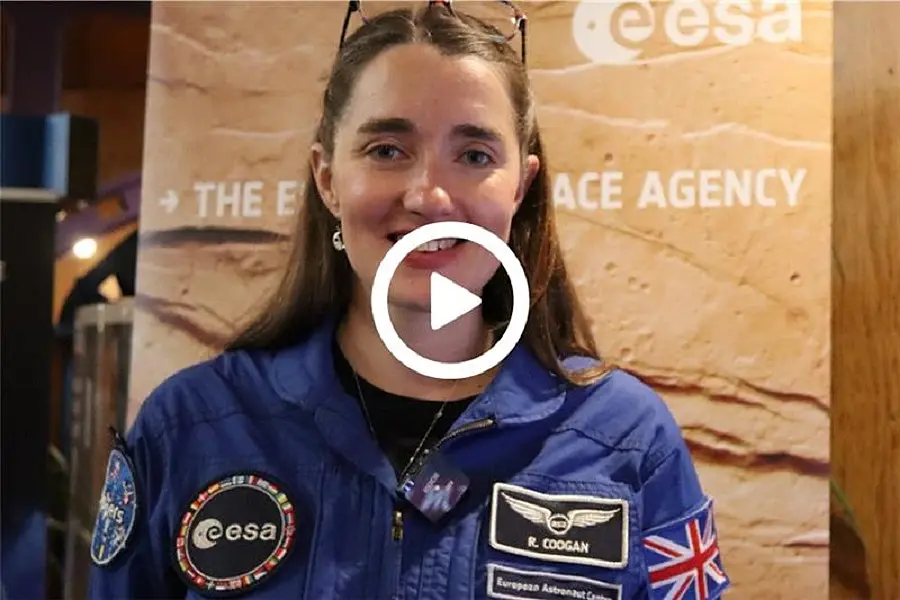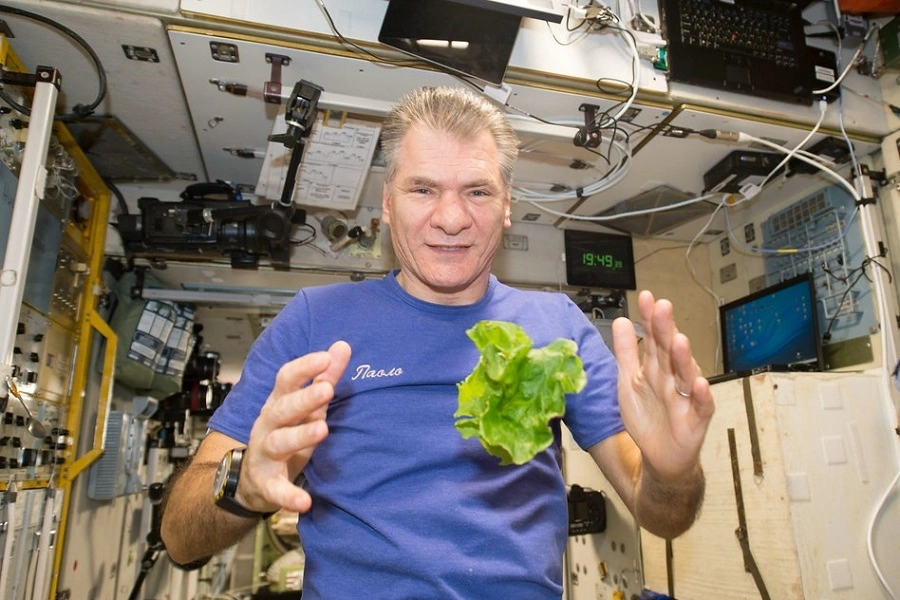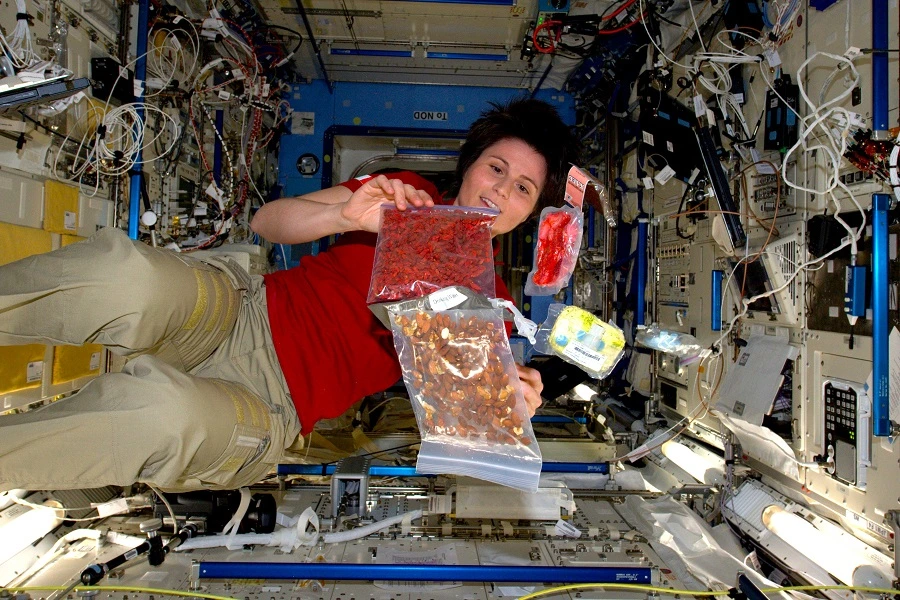Deep space exploration poses unique food challenges that stretch the limits of food science, such as altered taste buds in astronauts in space and the absence of fresh ingredients. Meals must remain safe, nutritious, and palatable for months without resupply while conserving water and resources in a closed environment.
Researchers are exploring how to grow fresh produce in orbit and apply cell-based or plant-based technologies to sustain life beyond Earth. For instance, the NASA-operated Vegetable Production System on the International Space Station (ISS) has helped astronauts grow small quantities of salad-type crops in microgravity, such as lettuce, mustard, and bok choy.
In 2019, cellular agriculture company Aleph Farms produced the “first” cultivated meat in space by using 3D bioprinting technology aboard the ISS. This milestone was followed by another ISS experiment in 2022 to study the effects of reduced gravity on the growth and maturation of cow cells used to make cultivated steaks.
As research continues to push the boundaries of how food can be produced and preserved beyond Earth, astronauts themselves are offering valuable insight into the realities of eating and living in microgravity.
During the recent European Space Agency’s (ESA) Open Day at the European Space Research and Technology Centre (ESTEC) in Noordwijk, Netherlands, Food Ingredients First met with ESA astronaut Rosemary Coogan. Coogan shed light on the sensory and emotional role food plays in microgravity, the challenges of developing nutritious and appetizing food for space missions, and the lessons space food holds for sustainable nutrition back on Earth.
How is space food represented at ESA’s Open Day, and why is it important to highlight it?
Coogan: There’s a huge amount to see here today — every part of the ESTEC’s work is on display, including space food. It’s an essential part of space exploration. We can’t send up fresh supplies on the ISS every week — it can take months before new cargo arrives, so food must last long, stay nutritious, and still taste good.
 Watch our discussion with astronaut Coogan on taste, technology, and sustainability in space food.As we look toward returning to the Moon and eventually traveling deeper into the solar system, the need for sustainable, long-lasting food becomes even more critical. With increasing distances and time scales, we need to have healthy food that can sustain us for very long periods of time, or even start to think about making our own food.
Watch our discussion with astronaut Coogan on taste, technology, and sustainability in space food.As we look toward returning to the Moon and eventually traveling deeper into the solar system, the need for sustainable, long-lasting food becomes even more critical. With increasing distances and time scales, we need to have healthy food that can sustain us for very long periods of time, or even start to think about making our own food.
Events like ESA’s Open Day are fantastic for sparking curiosity. The real experts are here, and children always ask the best questions. It’s a two-way exchange — they learn about science and sustainability, and their creativity inspires new ideas. Public engagement is essential to the future of space exploration.
Is the taste and texture of food different in space compared to on Earth?
Coogan: I am still under training, so I have not eaten food in microgravity yet. But I have tried the same meals on the ground. They are surprisingly tasty. Many experienced astronauts, however, report that their sense of taste changes in space — food can seem blander. We do not fully understand why that happens yet, but that’s an important part to explore in space food research. Taste definitely plays an emotional role, and having enjoyable food is important for astronauts’ well-being during missions.
What foods do astronauts miss most while in space?
Coogan: Fresh food is what everyone misses the most — especially fruit. Crumbly foods aren’t practical because crumbs can float and interfere with equipment. So there’s a certain limitation to what you can and can’t have. That’s why research on growing fresh salad and leafy greens aboard the ISS is so exciting. It’s already been done successfully and is a big step toward producing fresh food in space.
 ESA astronaut Paolo Nespoli participated in lettuce cultivation experiments aboard the ISS as part of NASA’s Vegetable Production System (Image credit: ESA/NASA).How do you see plant-based and cell-based innovations supporting space food?
ESA astronaut Paolo Nespoli participated in lettuce cultivation experiments aboard the ISS as part of NASA’s Vegetable Production System (Image credit: ESA/NASA).How do you see plant-based and cell-based innovations supporting space food?
Coogan: We need to explore different solutions — from growing plants in orbit to producing food in new ways. These technologies don’t just help astronauts — they have clear benefits for Earth, too. Much of the research we do on the station about growing food in a difficult environment applies to places on Earth with agricultural issues. So astronauts are completely open to these ideas. We will need different foods produced in different ways to do that.
What sustainability lessons from space could help improve food systems on Earth?
Coogan: One of the biggest aspects of having food on the ISS or producing it is water, where over 90% of water is recycled. But it’s still limited, so we have to be careful with every drop. That mindset of sustainability, recycling, and efficiency applies directly to how we grow food here on Earth. Learning how to grow nutritious food with minimal water is a shared challenge on Earth and in space.
Finally, if you could redesign a meal for space, what would it be?
Coogan: The space food I’ve had so far has been very good, so I wouldn’t change much yet. But astronauts do get the opportunity to design some of their own “bonus” meals for missions, which is really special. It allows us to try something new and see if it can be adapted for space — for example, whether it can be dehydrated or tinned, as all food must be stored safely for long durations. It’s a creative challenge that combines comfort and science, and I’ve only heard positive things from colleagues who’ve done it.

